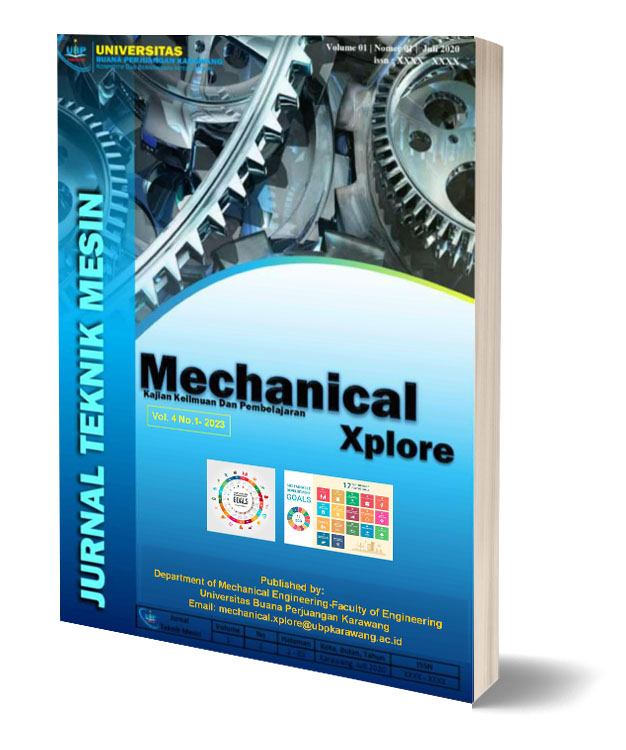The High Accurate Automatic School Bell Controller Based On Arduino Uno DS1307 I2C Real-time Clock
DOI:
https://doi.org/10.36805/jtmmx.v4i1.3499Keywords:
Automatic school bell, Arduino Uno, System development life cycle, Real-time clockAbstract
Education plays a crucial role in developing human resources with the necessary character and competence to meet the demands of the future Industrial 4.0 revolution. To ensure the effectiveness of the teaching and learning process, schools require supporting facilities and infrastructure. One such component is the school bell, which helps teachers notify students of daily schedules. As technology advances, some schools have adopted an automatic school bell as an alternative to traditional bells. These automatic school bells use Arduino microcontroller technology to ring at scheduled times, automatically improving accuracy and convenience. By utilizing sound output via an Arduino-based system, every created information can be easily delivered and reached. This study follows the System Development Life Cycle (SDLC) method, a widely used system development methodology encompassing hardware and software systems. The research successfully demonstrates an automatic school bell system capable of automatically producing notification sounds, optimizing electricity consumption, and generating precise sound frequencies during teaching and learning activities. The output voltage and current results at various parts of the automatic school bell system range from 4.17 to 5.90 volts and 488 to 602 mA, respectively. At the same time, power consumption achieved about 2.07 to 3.38 Watts. An automatic school bell system simplifies ringing the school bell as it seamlessly integrates with the scheduled timetable (software). As a result, the automatic school bell now rings automatically according to the pre-defined schedule, enhancing efficiency and ensuring timely transitions between classes and breaks.
References
B. Chazan, Principles and pedagogies in Jewish education. 2021. doi: 10.1007/978-3-030-83925-3.
S. J. Bell, G. J. Whitwell, and B. A. Lukas, “Schools of thought in organizational learning,” J. Acad. Mark. Sci., vol. 30, no. 1, pp. 70–86, 2002, doi: 10.1177/03079459994335.
C. Bjork and D. Susanti, “International Journal of Educational Development Can community participation leverage changes in teacher behavior ? Evidence from remote areas of Indonesia,” Int. J. Educ. Dev., vol. 102, no. July, p. 102840, 2023, doi: 10.1016/j.ijedudev.2023.102840.
Rrepiliya, “Teori Dasar Bel Sekolah Otomatis,” repiliya.wordpress.com, 2019. repiliya.wordpress.com (accessed Dec. 12, 2023).
K. M. Cooper, V. R. Downing, and S. E. Brownell, “The influence of active learning practices on student anxiety in large-enrollment college science classrooms,” Int. J. STEM Educ., vol. 5, no. 1, 2018, doi: 10.1186/s40594-018-0123-6.
A. Linarta and N. Nurhadi, “APLIKASI BEL SEKOLAH OTOMATIS BERBASIS ARDUINO DILENGKAPI DENGAN OUTPUT SUARA,” J. Inform. Manaj. dan Komput., vol. 10, no. 2, pp. 1–7, 2018.
D. Satria and Y. Yanti, “Design of Arduino Uno Based School Bell Scheduling System with Web-Based Interface Using Ethernet Web Server,” Serambi Eng., vol. II, no. 3, pp. 141–147, 2017, [Online]. Available: http://jurnalserambiengineering.net/wp-content/uploads/2017/07/Rancang-Bangun-Sistem-Penjadwalan-Bel-Sekolah-Berbasis-Arduino-Uno-dengan-Antarmuka-Berbasis-Web-Menggunakan-Ethernet-Web-Server.pdf
J. Minsyah Putra, “Prototype Smart Classroom Berbasis Mikrokontroller Menggunakan Sensor LDR dan LM35,” Universitas Islam Negeri Ar-Raniry, 2020.
AVR Studio®, “ATmega328P 8-bit AVR Microcontroller with 32K Bytes In-System Programmable Flash DATASHEET,” 2016. [Online]. Available: https://ww1.microchip.com/downloads/en/DeviceDoc/Atmel-7810-Automotive-Microcontrollers-ATmega328P_Datasheet.pdf
G. Guerrero-Ulloa, C. Rodríguez-Domínguez, and M. J. Hornos, “Agile Methodologies Applied to the Development of Internet of Things (IoT)-Based Systems: A Review,” Sensors, vol. 23, no. 2, 2023, doi: 10.3390/s23020790.
R. A. Nanda, A. Arhami, and R. Kurniawan, “Perancangan Dan Pengujian Model Mobil Robot Penanam Bibit Kangkung,” Rona Tek. Pertan., vol. 13, no. 2, pp. 14–28, 2020, doi: 10.17969/rtp.v13i2.16982.
H. Al Fatta, Analisis dan perancangan sistem informasi untuk keunggulan bersaing perusahaan dan organisasi modern. Yogyakarta: ANDY, 2007.
F. Mulyadi, A. Rakhman, and A. Basit, “SISTEM PERINGATAN DINI KEBAKARAN BERBASIS IoT Di PERUMAHAN NDALEM PARIKESIT,” Politek. Harapan Bersama Tegal, no. February, p. 6, 2021.
R. Aulia Nanda, A. Supriyanto, and F. Mubina Dewadi, “Penggunaan Sensor MPX5500DP Untuk Monitoring Sistem HVAC Berbasis Mikrokontroler dan IOT,” Rekayasa Energi Manufaktur) J. |, vol. 8, no. 1, pp. 2528–3723, 2023, [Online]. Available: http://doi.org/10.21070/rem.v8i1.1660
R. Hermana, Y. Setyoadi, and M. F. Aza, “A Comparative Study: The Precision of CNC Machines Using a Sliding Mode Controller (SMC) and a Wi-Fi ESP32,” J. Tek. Mesin Mech. Xplore, vol. 3, no. 2, pp. 49–57, 2022.
A. Rahmadiansyah, E. Orlanda, M. Wijaya, H. W. Nugroho, and R. Firmansyah, “Perancangan Sistem Telemetri Untuk Mengukur Intensitas Cahaya Berbasis Sensor Light Dependent Resistor Dan Arduino Uno,” JEEE-U (Journal Electr. Electron. Eng., vol. 1, no. 1, pp. 15–21, 2017, doi: 10.21070/jeee-u.v1i1.760.
K. Hidayatulloh, M. K. MZ, and A. Sutanti, “Perancangan Aplikasi Pengolahan Data Dana Sehat Pada Rumah Sakit Umum Muhammadiyah Metro,” J. Mhs. Ilmu Komput., vol. 1, no. 1, pp. 18–22, 2020, doi: 10.24127/.v1i1.122.
R. LeSar and R. LeSar, “Materials selection and design,” Introd. to Comput. Mater. Sci., pp. 269–278, 2013, doi: 10.1017/cbo9781139033398.015.
I. M. Ivan WCS, M. Darsin, G. Jatisukamto, and M. S. Hussin, “Design of Portable Cartesian 3D Printer Using Arduino Mega 2560,” J. 3D Print. Addit. Manuf., vol. 1, no. 1, pp. 1–9, 2021, [Online]. Available: https://crgjournals.com/3dprinting/articles/design-of-portable-cartesian-3d-printer-using-arduino-mega-2560lt
U. Arduino Uno, “Arduino UNO R3 Features,” 2022. [Online]. Available: https://docs.arduino.cc/resources/datasheets/A000066-datasheet.pdf
R. Electronics, “DS1307 I2C Real Time Clock Module.” [Online]. Available: http://www.atomsindustries.com/ASD1028
M. S. Liu, M. C. C. Lin, I. Te Huang, and C. C. Wang, “Enhancement of thermal conductivity with CuO for nanofluids,” Chem. Eng. Technol., vol. 29, no. 1, pp. 72–77, 2006, doi: 10.1002/ceat.200500184.
F. Electronic, “LCD 16X2 1602 With I2C LCD Controller Module COM41,R11,” 2022. https://www.faranux.com/product/lcd-16x2-with-i2c-lcd-controller-module-com41/ (accessed Jun. 15, 2023).
R. C. Van Nostrand, Design of Experiments Using the Taguchi Approach: 16 Steps to Product and Process Improvement, vol. 44, no. 3. 2002. doi: 10.1198/004017002320256440.
C. Soares, Inlets, Exhausts, and Noise Suppression. 2015. doi: 10.1016/b978-0-12-410461-7.00006-7.
W. LAUTERBORN and J. HOLZFUSS, “Acoustic Chaos,” in International Journal of Bifurcation and Chaos, vol. 01, no. 01, 1991, pp. 13–26. doi: 10.1142/s0218127491000038.
A. J. Zuckerwar, “Acoustical Measurement,” Encycl. Phys. Sci. Technol., pp. 91–115, 2003, doi: 10.1016/b0-12-227410-5/00008-9.





